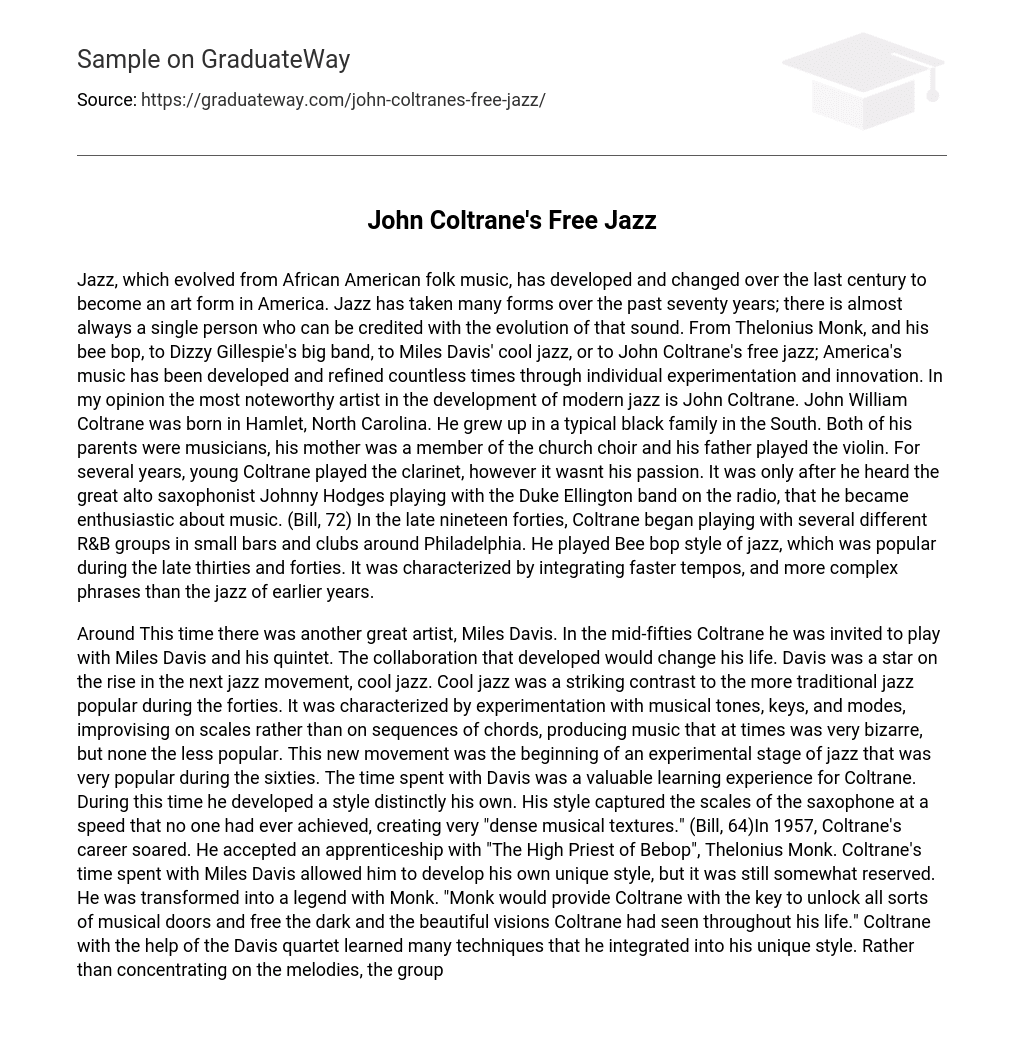Jazz, which evolved from African American folk music, has developed and changed over the last century to become an art form in America. Jazz has taken many forms over the past seventy years; there is almost always a single person who can be credited with the evolution of that sound. From Thelonius Monk, and his bee bop, to Dizzy Gillespie’s big band, to Miles Davis’ cool jazz, or to John Coltrane’s free jazz; America’s music has been developed and refined countless times through individual experimentation and innovation. In my opinion the most noteworthy artist in the development of modern jazz is John Coltrane. John William Coltrane was born in Hamlet, North Carolina. He grew up in a typical black family in the South. Both of his parents were musicians, his mother was a member of the church choir and his father played the violin. For several years, young Coltrane played the clarinet, however it wasnt his passion. It was only after he heard the great alto saxophonist Johnny Hodges playing with the Duke Ellington band on the radio, that he became enthusiastic about music. (Bill, 72) In the late nineteen forties, Coltrane began playing with several different R&B groups in small bars and clubs around Philadelphia. He played Bee bop style of jazz, which was popular during the late thirties and forties. It was characterized by integrating faster tempos, and more complex phrases than the jazz of earlier years.
Around This time there was another great artist, Miles Davis. In the mid-fifties Coltrane he was invited to play with Miles Davis and his quintet. The collaboration that developed would change his life. Davis was a star on the rise in the next jazz movement, cool jazz. Cool jazz was a striking contrast to the more traditional jazz popular during the forties. It was characterized by experimentation with musical tones, keys, and modes, improvising on scales rather than on sequences of chords, producing music that at times was very bizarre, but none the less popular. This new movement was the beginning of an experimental stage of jazz that was very popular during the sixties. The time spent with Davis was a valuable learning experience for Coltrane. During this time he developed a style distinctly his own. His style captured the scales of the saxophone at a speed that no one had ever achieved, creating very “dense musical textures.” (Bill, 64)In 1957, Coltrane’s career soared. He accepted an apprenticeship with “The High Priest of Bebop”, Thelonius Monk. Coltrane’s time spent with Miles Davis allowed him to develop his own unique style, but it was still somewhat reserved. He was transformed into a legend with Monk. “Monk would provide Coltrane with the key to unlock all sorts of musical doors and free the dark and the beautiful visions Coltrane had seen throughout his life.” Coltrane with the help of the Davis quartet learned many techniques that he integrated into his unique style. Rather than concentrating on the melodies, the group concentrated on the harmonic arrangement of a piece. His most noteworthy recording during this time was “Blue Trane” (1957), one of several albums in his career that would be widely acclaimed. At the end of 1958, Coltrane began to embark in solo careers in the jazz. During that same year, with the help of a variety of artists he recorded over twenty different albums and was widely respected by his fellow musicians. The John Coltrane quartet included tribal music from India, the Middle East and Africa with that of the movement, free jazz’. Free jazz kept away from the structured sounds of the bee bop and cool jazz eras. Instead, there was the absence of any organization, direction, or tonality, and was distinguished by random improvisation. (Simpkins 191) In conclusion you can say the world of jazz belonged to Coltrane during the sixties but on July 17, 1967 John Coltrane died of liver cancer. His music was uniquely original and was able to capture the vast range of experimentation and growth of American Jazz of the 1950’s and 60’s. (DWP) Coltrane’s creativity has shaped and inspired many young jazz artists and he definitely pushed the boundaries of Jazz.
BibliographyCole, Bill. “John Coltrane.” Schirer Books 1976, New York: 69-72, 108-111.
Dave Wild’s Wild Place. “John Coltrane” sited (May 24,2004)http://home.att.net/dawild/john_coltrane.htmSimpkins, Cuthbert Ormond. “Coltrane: A Biography.” Black Classic Press 1989, Baltimore, Maryland. 154, 178, 189-192





